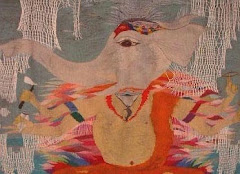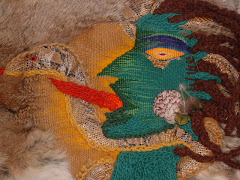Friday, October 31, 2008
Healings in Endings: Dying to the Fear of Death
I was raised to be afraid of death and the dead. My mom never thought dead or dying was a good idea. She did believe, however, that it was best for me, at age five, to see my grandfather lying in his coffin than to never have met him at all. We didn’t talk about it and I knew the subject was taboo after that.
Soon after I arrive home from India after the tsunami, a friend needs help with her husband who is dying of stomach cancer. I gulp down my fear as I enter the room in my friend’s home, see the husband lying ridgid and skeletal on the rented hospital bed. With my friend’s permission, I sit next to him and chant. During the droning sound his facial muscles relax and his hands let go of whatever they’ve been holding on to, and so do mine.
One day about two weeks before his death, he lifts his head and his eyes take on that translucent brilliance of the visionary, of someone seeing an angel or a god, something above and behind me. His wife sees him seeing something; later she says she doesn’t want me chanting for him any longer. Now when I arrive to help out, the TV in her husband’s room is on full volume, telecasting an incessant barrage of football games.
After that experience, I took the ten-week hospice training course and became a volunteer. One of my patients, Ann, was dying of breast cancer. We kept a pile of maroon towels on hand in case the fine membrane between her breast wound and heart would break. I’d eye the towels and wonder if I could manage it. While lying in her hospital bed in a room in her nephew’s home, with a view out to trees turning to fall, Ann would hold my hand in long silences. “How do you meditate?” she asked a couple of days before she died. “You’re already doing it,” I said. “All it is really, is being still and quiet and letting all that nature in, and all that’s beyond it, too.” She turned her head towards the window, her eyes deepening like pools in a forest.
Mary, dying of an unusual kind of stomach cancer, loved food and feared the aftermath of eating because she couldn’t keep anything down. The first time I opened the door into her house and smelled the vomit, I was sure I’d retch before my three-hour visit was up. Taking a few deep breaths, I sat on the couch with her and then listened—just opened my heart and listened. She told me her life story, said she wanted to die.
One day she told me that before her husband died, she’d waked up in the middle of the night with an intuition to go to him in the nursing home and let him know it was okay for him to die. He passed away the next week. Ann confessed that she feared she’d killed him. I assured her she simply allowed him permission to go peacefully. She said, “I wish my children would tell me it’s okay to die.” And, with a little coaching, they did. Previously Mary’s three adult children had thought all their mom needed was more exercise and doing for herself. I had a quiet image of Mary, smiling and full of energy, paddling a canoe down the River Styx, into the sunset. She died soon after while holding her daughter’s hand.
When I asked Gerry Gregersen, Program Director of Hospice of Hancock County in Maine, about death as nexus for transformation, she said sometimes with families that have been experiencing discord—separation, anger, and whatever—something changes, or someone changes. Gerry told of a feisty 74-year-old women dying of ovarian cancer. “She had four adult children—a daughter who lived close by and took care of most things most of the time, but was emotionally unavailable. A successful son who worked for a corporation, the manager who would figure things out, but who was not present for his mother. A daughter who was emotionally available, but lived far away and had to take care of her small children. At the time of the mother’s death, they all rallied around, and these three children pretty much kept to their usual roles.
“In the mother’s final days, the one who came through with the most caring attention, was the fourth son, the black sheep, the deadbeat drug addict. The dying mother had affection for this son, but she was always worried about him. As she lay in her hospital bed in her bedroom, when she was in pain, this son would give her the prescribed drugs and joke, ‘If she only knew who was doing this.’ He knew exactly what place he had in the hierarchy of siblings and it didn’t matter to him. What mattered was that he was there, giving the longest shifts, doing the hardest work, being the most present. I don’t know if his siblings were aware of how perfect that was. He was aware and I was aware.”
Conclusion
In hospice there is the undergirding belief that one can live well, while dying. To this end, everyone involved makes every effort to keep the patient as comfortable and pain-free as possible, paying attention to the person’s needs and wishes, allowing silences and deep rest as the body and mind go through settlings in the final days.
Once I was called to help Ann in the middle of the night because she had a sharp pain that frightened her. At the time she was living alone, without a primary care-giver. She decided to go to the hospital. For hospice clients, ambulance folks knew not turn on the siren and to be sensitive to the patient’s wishes. And if there was a “Do Not Resuscitate” order, which Ann had, they knew not to perform heroics to keep the patient alive.
Ann's distress had disappeared; she was in some discomfort as the ambulance made its way to the hospital, but she didn’t need anything more than a caring presence.
The Advance Directive (see links below). When we arrived at the hospital, I showed the medical personnel Ann’s "advance directive," a legal document that spelled out her desires for medical care and for personal and spiritual preferences. Some patients want music; Ann didn’t. Some want prayers; Ann didn’t. Some want certain medical interventions and not others; Ann wanted minimal medical intervention; she just needed to feel safe and she felt safe in the hospital that night. Most want pain medication; Ann did not, not even in the end. She didn’t want drugs, or to be kept alive by artificial means. She wanted to allow death to come naturally and to leave the world with dignity.
Ann died in her nephew’s home about a week later, holding her sister’s hand on one side and, on her other side, the hand of the hospice volunteer who stood vigil that night.
There is no horror in death. The soul leaves the body as a boy jumps out of a school door, suddenly, and with joy.
—from the movie, “A Rumor of Angels”
Credit:
“A Rumor of Angles” starring Vanessa Redgrave, is based on, Thy Son Liveth: Message from A Soldier To His Mother (1919) by Grace Duffie Boylan
NOTE: An "advance directive" is good to have in place no matter how old you are. You never know what will happen and the directive assures you that you'll be taken care of according to your wishes should you have an accident or suddenly become ill.
Five Wishes: Living with Dignity While Sick, Injured, or Dying: www.agingwithdignity.org/5wishes.html
Advance directive explained: http://www.dora.state.co.us/Insurance/senior/stern12.pdf
Subscribe to:
Post Comments (Atom)








No comments:
Post a Comment